How ’Bout Them Apples!
October 1, 2018 | 13 min to read
Growers are innovating to enhance apple variety offerings, with the Gala set to rise as the favorite, overtaking the classic Red Delicious. Innovations in storage are allowing for year-round availability. Retailers need to emphasize the growing demand for organic apples, tailoring their mix to consumer preferences while promoting new varieties like Smitten and Honeycrisp. Seasonal promotions, tasteful displays, and thoughtful cross-merchandising increase apple sales, highlighting their year-round appeal.
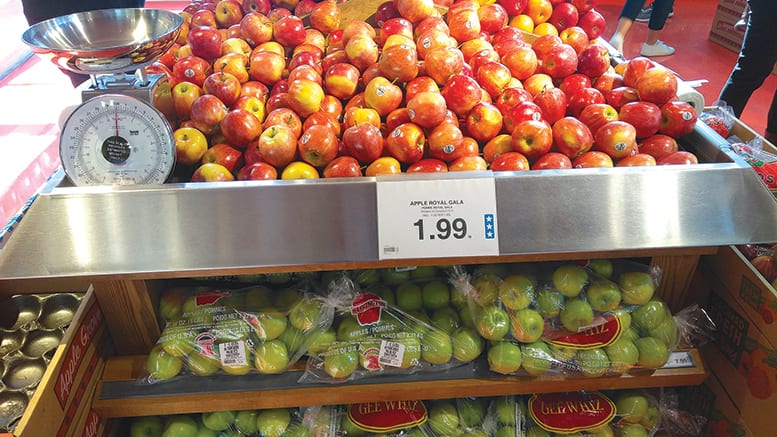
Originally printed in the October 2018 issue of Produce Business.
A steady push by growers to launch new varieties, fueled by consistent popularity, means retailers can easily display the fruit year-round.
The Gala is rising. After more than 50 years as the top U.S.-grown apple, the Red Delicious, still a favorite, is expected to claim second place. Apples with relatively newer names, Envy, Cheekie, SugarBee and Smitten – a handful of the more than 100 varieties sold at retail – will vie for space on shelves and in shopping carts this season. Innovators have their eyes on the next big apple, and innovations in dynamic control atmosphere storage are keeping apples fresh for consumers long after harvest.
Add to the buzz a USDA crop estimate of 272.7 million units – nudging past 2017’s 271.6 million units and record-setting farm gate value of $3.55 billion – and what better time than now to reap the benefits of merchandising apples year-round.
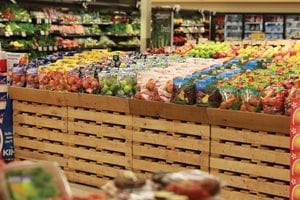 “Apples make up 6-8 percent of dollar sales in the produce department,” says Roger Pepperl, marketing director for Stemilt Growers in Wenatchee, WA. “That’s huge. It’s not just important to us; it’s important to the retailer that they take care of this large segment of sales.”
“Apples make up 6-8 percent of dollar sales in the produce department,” says Roger Pepperl, marketing director for Stemilt Growers in Wenatchee, WA. “That’s huge. It’s not just important to us; it’s important to the retailer that they take care of this large segment of sales.”
“There’s a core group of customers that buys apples every week,” says Andy Tudor, vice president of business development for Rainier Fruit Co. in Selah, WA. “We don’t gap our supply in the summer anymore. We’ve learned how to store them for a full season.”
Given the advances in dynamic control atmosphere storage, with a boost from late-season varieties such as RubyFrost, “We’re able to go a lot longer with crunchy, crispy fruit,” says Austin Fowler, owner of Fowler Farms near Lake Ontario, NY.
“The seasons are blurred, so it’s our job to keep consumers and retailers interested and engaged,” says Nick Mascari, vice president of sales for grower/packer/shipper All Fresh GPS in Sparta, MI.
With the 2018 apple year still fresh, industry experts shared their thoughts on some of the top ways to get the most from merchandising apples year-round.
For starters, George Harter, vice president of marketing for CMI Orchards in Wenatchee, urges retailers “to think outside the box.”
“What could I do that’s drastically different to get incremental sales? … How can I work with my apple supplier to schedule and execute exciting promotions and display vehicles? Talk to your apple supplier to see what those ideas may be — ad features and displays and themes and promotions,” Harter says.
WHAT’S HOT
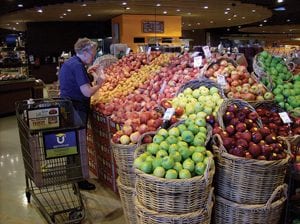 According to the U.S. Apple Association, the Falls Church, VA-based organization that represents the nation´s 7,500 apple growers and regional associations, the top 10 varieties sold in America are: Gala, Red Delicious, Fuji, Granny Smith, Honeycrisp, Golden Delicious, McIntosh, Cripps Pink/Pink Lady, Braeburn and Jazz. But that’s just where the story starts. Pepperl says, “There are a lot of apple varieties out there.”
According to the U.S. Apple Association, the Falls Church, VA-based organization that represents the nation´s 7,500 apple growers and regional associations, the top 10 varieties sold in America are: Gala, Red Delicious, Fuji, Granny Smith, Honeycrisp, Golden Delicious, McIntosh, Cripps Pink/Pink Lady, Braeburn and Jazz. But that’s just where the story starts. Pepperl says, “There are a lot of apple varieties out there.”
“What’s hot in terms of a popular variety is really what the consumer considers to be his or her personal favorite – and everyone has one,” says Cynthia Haskins, president and CEO of the New York Apple Association (NYAA) based in Fishers, NY. “Some like the newest varieties, others like the classics, and a wide swath of people crave all the diverse varieties in between.”
“Honeycrisp is always at the top of the list for what’s ‘hot,’ ” says Chuck Sinks, president of sales and marketing for Sage Fruit Company in Yakima, WA. “But, this year, we will also be shipping Smitten apples – both organic and conventional – and that’s something we are very excited about. These apples should be demoed, given front-of-the-department displays, etc.”
Jeff Cady, director of produce and floral for the 169-store Tops Friendly Markets chain based in Williamsville, NY, says the move to managed varieties is a trend in Tops stores. “We’ve been pushing those, moving away from the traditional varieties. In most instances, customers are trading up in dollars, buying a little more expensive, proprietary fruit. We’ve had some success with doing it.”
FINDING THE BLEND
Among the vast resources the apple industry offers retailers is help sorting through the variety of fruit to find the right mix. It’s an art based in science, where consumer scan data is key. “Putting these varieties out there, getting behind promoting them and measuring results help you make plans for the coming season,” says Rainier’s Tudor.
“It’s not enough for us just to be sales guys,” says Mascari, vice president of sales for All Fresh GPS, Sparta, MI. “We have to add value to our customers and retailers. I’d love to sell my customers all 21 varieties we sell. But we want to look at all their stores and geography and give them the assortment that works. It’s all about tailoring that program to the customer, and even more micro, to that store, to that area. At the same time, you don’t want to pigeonhole somebody. Maybe you … display a higher-end apple on a smaller scale. It’s finding that fine line.”
“It’s not enough for us just to be sales guys. We have to add value to our customers and retailers. I’d love to sell my customers all 21 varieties we sell. But we want to look at all their stores and geography and give them the assortment that works. ”
— Nick Mascari, All Fresh GPS
The NYAA’s Haskins says that “it’s best to offer a good mix of sweet-to-tart apple varieties, so consumers will find a variety that suits them.”
“New apple varieties are coming out all the time, so it’s natural for retailers to want to focus on what’s new,” she says. “What’s more important, though, is to offer a good mix of new and classic varieties because consumers have personal and powerful emotional associations with the varieties they like.”
From Fowler’s perspective, as the grower of more than 20 different varieties, erring on the side of more is a good strategy. “People who carry more varieties seem to do better than others,” he says. “It shows consumers they’re serious about apples.”
In addition to choosing from the array of options, retailers must determine how to mix organic versus conventional, and bags versus bulk. “You have to be careful that you honor your consumers’ purchasing patterns to figure out what that mix is,” says Pepperl. “Traditionally, the bulk-to-bag ratio is 70-30 … You don’t need every item you have in bulk to be in a bag.”
ADDING IN ORGANICS
Apple experts say consumers’ demand for organic apple varieties is on the rise, and in Washington – which grows 90 percent of U.S. certified organic apples – production is increasing, according to the Washington State Tree Fruit Association. The 2018 organic crop is projected to be 14 percent of the total, or 18.9 million boxes of the state’s estimated 131 million-box crop.
Organic apple sales are up at the Tops Markets, where Cady’s display strategy is to “integrate them. We put them above the conventional ones, so people can compare prices.”
Stemilt’s Pepperl says, “Not only do organics need space – whether segregated or integrated – they need to have an end-cap or satellite display occasionally. That’s been our big promotional message to retailers. Give us some promotional space on organic to excite the crowd.”
Tudor says retailers with a strong organic game may choose to start in August with an organic Gala and continue through the season without adding a conventional version. (Rainier grows both organic and conventional Galas.) This opens up another SKU and can lead to higher register rings. But that’s still a big leap for many retailers, he says. “The hardest part about making moves like this is that, over the years, produce has always been very traditional. You’ve got to … be willing to try some new things. But you can’t do them off your gut. You have to do them based off data.”
MANAGING THE MIX
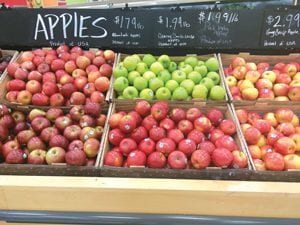 Choosing from the bountiful apple varieties goes hand-in-hand with planning the flow.
Choosing from the bountiful apple varieties goes hand-in-hand with planning the flow.
“We do manage it, but it’s not easy,” says Cady of Tops Markets. “There are so many varieties. We have our core items – Empires, McIntoshes, Galas, Honeycrisps, etc. – and we bring in one or two special varieties a month. We have an enter and exit date.”
“When people are given too many choices, they often don’t make one at all,” says Sage Fruit Company’s Sinks. “There should be a limit on the number of apples being merchandised at any given time. However, varieties can also be rotated throughout the year to effectively give the consumer more options, but not all at once,” says Sinks.
“Once the season starts, I have apples on sale every week,” says Marc Goldman, produce director for Morton Williams, the Bronx-based chain of 15 stores in the New York Metropolitan area. “I go according to what the customers like. Everybody wants Honeycrisp. I try to promote that as much as possible. I promote an apple every week and rotate it around.”
DISPLAY NOTES
How much display space should retailers apportion to apples?
“The optimum space is as much as we can get,” says Rainier’s Tudor. “As a grower and packer, it’s our job to be responsible to that retailers and help them carry and allot space to what is making the most dollars.”
According to Sinks, “Most important with regards to merchandising is to allocate appropriate space by variety, commensurate with its volume movement. In other words, if Honeycrisp is the best-selling by volume, it should have the largest space.”
“We have a lot of space right now,” says Pepperl. “We pretty much have a good 10 percent of a retailer’s space during apple season. There are so many new products; everyone wants that promotable space. But you have to give it to apples or you’re going to fail as a retailer.”
Mascari of All Fresh GPS says the new varieties “really need an end cap, or a bin, or shipper to draw them out from the other varieties.”
Acording to Fowler, the freshness of the display matters more to him than the size: “When we go to the stores, we certainly like see a good turn. Unfortunately, you’re going to have some shrink. But if you have too many apples that have fallen … or are damaged, no one buys any apples. You have to keep that turn.”
DESIGN WITH COLOR
To differentiate varieties, the apple experts recommend maximizing nature’s color palette. At the Morton Williams supermarkets, where space is at a premium, eye appeal is top of mind, says Goldman.
“With most things I do, I like to break the color. I break with Golden Delicious and Granny Smith. But there are only two of those versus 10 or 12 red apples. So, I’ll take oranges or grapefruit and put them in the middle. It makes the color pop more. There are so many different colors in produce. You’ve got to use the color to call attention to the items.”
Fowler agrees. “It’s important to separate apples, so everything doesn’t look like a Gala, Fuji or Honeycrisp. It makes a pretty display,” he says.
Cady is a stickler for color ribboning at the 169 Tops Friendly Markets stores. “If you’re leading one of these displays with a green apple, I’m liable to hit you up-side the head. Use the green ones to separate. I want a color break.”
TEMPT WITH DEMOS
Shoppers unfamiliar with the flavor profiles of the multitude of apples may pass them up, particularly when they’re priced higher than their tried-and-true favorites. Demos can be the key to unlocking those sales.
All Fresh GPS is among the companies that fund demos – staffed and passive – for retailers. “If you pay $2.99 a pound and up for an apple, you want to make sure your money is going to a great piece of eating fruit,” says Mascari.
Cady says in-store demos are essential when rolling out new varieties. “With Honeycrisp, people know – the name gives you what the texture is, and what it tastes like.” When that’s not the case, “you’d better put some demo money or sampling money behind it. Or go really cheap in retails so we can put it in their cart that way,” he says.
Signs are another important tool for differentiating apple varieties and promoting sales.
“Even with the legacy varieties, you want great signage, because as apples all sort of start to mesh together, you want them to be able to find their favorite apples,” Mascari says. “If you have 50 apples out there, you want to make it easy on the consumer. Any more, it’s all about time. They don’t want to waste time looking for what they want.”
“We’re big on descriptors; you have to tell people what the varieties are,” says Pepperl. “It’s really a barrier to purchase when you don’t know what an apple’s going to be. The expense can be a challenge. If you’re offering a $1.59-a-pound Gala or a $2.99-a-pound SweeTango, you’d better give them a good reason to buy the SweeTango.”
CELEBRATING LOCAL
Apples from nearby orchards – across town or across state – create promotional opportunities for retailers in the 32 states where apples are commercially grown, and especially in the Big 10: Washington, New York, Michigan, Pennsylvania, California, Virginia, North Carolina, Oregon, Ohio and Idaho.
“In the Northwest, you will definitely see an emphasis on ‘local,’ given the proximity to orchards, and you’ll likely find that in New York, Michigan and Minnesota, as well,” says Sage Fruit Company’s Sinks. “However, one common theme that doesn’t stray too far from ‘local’ that you can see in various markets is ‘farm fresh.’ ”
Making a farm-to-table connection with consumers is one of the strategies Michigan-based All Fresh GPS employs on behalf of retailers. “We put ‘meet the grower’ pieces together. We’ve even done demos where the farmer’s there. People want to know where their food comes from … We can make that connection between the farmer and the consumer,” Mascari says.
“We’re sitting in middle of Apple Country in New York,” says Cady. “Apples always have a forward-facing home category display 365 days a year for us.”
CROSS MERCHANDISING
Cross-merchandising is a reliable vehicle for increasing sales, and industry experts say apples present plenty of opportunities.
“Cheese is a gimme,” says Cady.
“New York apples and ciders pair well with nuts, cheese, dips, spreads and can be used in numerous ways, from baking, to cooking, in salads, in beverages, as snacks and even paired with a protein to make a satisfying meal alternative that is convenient, tasty and satisfying,” says the NYAA’s Haskins.
“Cross-merchandising with caramel or ingredients for pies is great. But, for a healthier take, perhaps try merchandising with steel-cut oats for a breakfast idea, or with other items in the produce department for a flavorful salad. Pair the displays with recipes and give the consumer an idea on how to use the items,” says Sinks, of the Sage Fruit Co.
Mascari suggests moving apples outside produce department boundaries: “Get apples into the cereal aisle, and near the checkout, where people can pick them up on the go.”
Tops has been successful with the grab-and-go concept by the checkout aisles. “We learned from bananas, and thought, ‘why not try apples?’ Sometimes we get some love there,” says Cady.
HOLIDAY TIE-INS
Apples add luster to produce department sales during the holiday-studded fourth quarter.
Sinks says it’s the perfect opportunity to showcase different varieties. “For example, during the month of October (Halloween), cross-merchandise Granny Smith apples with caramel sauce for candied apples. In November and December, highlight varieties that are best for making pies,” he says.
“During October (Halloween), cross-merchandise Granny Smith apples with caramel sauce for candied apples. In November and December, highlight varieties that are best for making pie. ”
— Chuck Sinks, Sage Fruit Company
“Thanksgiving and Christmas are baking holidays,” says Rainer’s Tudor. “That’s a popular time to promote Granny Smith and some of the other apples good for baking.”
In January, the twin promotional themes of wellness and back to school kick off sales that continue strong through April, says Pepperl.
“In late spring and summer, we are constantly preaching that even though apples aren’t on the top of customers’ minds, you must have good representation,” says CMI’s Harter.
Adding a festive event to your promotional year can jazz up sales. “We try to do some sort of extravaganza with our customers, like an Apple Fest; something that draws attention to the variety and draws people to apples. That’s super, super important,” says Pepperl. “The big thing we’re looking more for out of retailers is to make sure they’re giving us that ‘celebration space,’ … for one to two weeks occasionally, to bust out of the department and get a front-end display.”
The NYAA will host a Holiday Display Contest Extravaganza Nov. 1 through Dec. 31, “to inspire retailers to build displays that show case New York apples and ciders,” says Haskins, and prizes will include an all-expense paid trip through New York’s apple-growing region.
Haskins says apple consumption is “always steady and slightly increasing. Sales of apples throughout the year stay steady too because apples are available year-round and are convenient, versatile and tasty.”
As consumers discover and crown new favorites, Fowler is hopeful consumption will continue to grow.
“I think that with some of these newer varieties that eat a lot better, there’s more excitement out there for good apples,” he says. “I’m pretty optimistic that if we get behind these things and do what we should as growers, packers and shippers, we will drive consumption upward.”
VALUE-ADDED APPLES
Timesaving and convenient, grab-and-go packages of sliced apples have become produce department staples year-round and continue to offer new value-added sales opportunities.
“Sliced apples offer great convenience to consumers, and sales of them have grown significantly over the past 10 years,” says Cynthia Haskins, president and chief executive of the New York Apple Association. “It is important to include them near the front of the store so they are visible to consumers who want an instant snack. In addition to convenient sliced packs, 3- and 5-pound bags, totes and zipper pouches are all popular with on-the-go consumers too.”
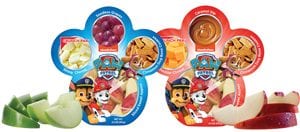 Crunch Pak, one of the largest producers of sliced apples in the United States, has products in 16,000 stores and continues to expand its product line to satisfy the demand for fresh and healthy snacks for children and adults. Serving sizes range from individual to party-size to foodservice. Apples, sweet, tart or mixed, are always the main feature but the Snacker line adds cheese and grapes or pretzels, and Dipperz products offer peanut butter or caramel.
Crunch Pak, one of the largest producers of sliced apples in the United States, has products in 16,000 stores and continues to expand its product line to satisfy the demand for fresh and healthy snacks for children and adults. Serving sizes range from individual to party-size to foodservice. Apples, sweet, tart or mixed, are always the main feature but the Snacker line adds cheese and grapes or pretzels, and Dipperz products offer peanut butter or caramel.
Organic options are also popular, “about 30-40 percent of our business,” says Tony Freytag, a founder and executive vice president of the Cashmere, WA-based vCrunch Pak. And peeled apple slices, added several years ago, are now a mainstay as well. “We continue to see that item grow. We didn’t do peeled for many years. But a lot of parents, from what I’m told, were peeling our slices,” he says.
About two years ago, Freytag says Walmart asked the company to create a snack themed around PAW Patrol, a popular children’s show on the Nickelodeon channel. The result was two paw-shaped trays of apple slices, cheese (Cheddar or string), cinnamon “dog bone” cookies, and caramel or grapes. The packages are wrapped in kid-friendly graphics, bright red and blue and featuring PAW Patrol characters.
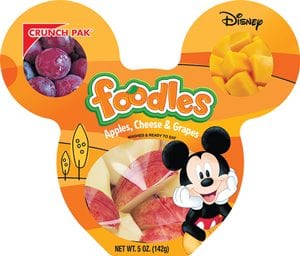 Crunch Pak’s partnership with Disney a few years earlier resulted in Foodles, Mickey Mouse-shaped trays featuring combinations of apples, cheese, grapes, pretzels and crackers. The Foodles format has been so popular it’s now in 8,000 stores and for at least one major retailer is the No. 1 and No. 2 top-selling snack item, says Freytag.
Crunch Pak’s partnership with Disney a few years earlier resulted in Foodles, Mickey Mouse-shaped trays featuring combinations of apples, cheese, grapes, pretzels and crackers. The Foodles format has been so popular it’s now in 8,000 stores and for at least one major retailer is the No. 1 and No. 2 top-selling snack item, says Freytag.
Marc Goldman, produce director for Morton Williams, the Bronx-based chain of 15 stores in the New York Metropolitan area, says it took time for sliced apples to gain traction in his stores, but they have found their niche. “It started out slow,” he says. “Now, in some stores they sell very well. It depends on the neighborhood. We merchandise it with the cut-fruit. People buy it for the kids in school. Sometimes in the fall we’ll even buy it in bulk and put it in the mixed fruit cups.”
Even though apples – and apple slices – are both year-round commodities, Freytag says the company sees a 10-15 percent drop in sales during the summer, when stone fruit and berries are in abundance. He says Crunch Pak is exploring other fruit and snack combinations, including meal replacements. But apples, he says, “will always be our core business.”
21 of 30 article in Produce Business October 2018

